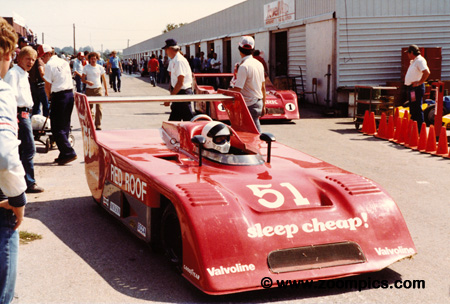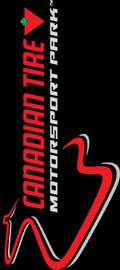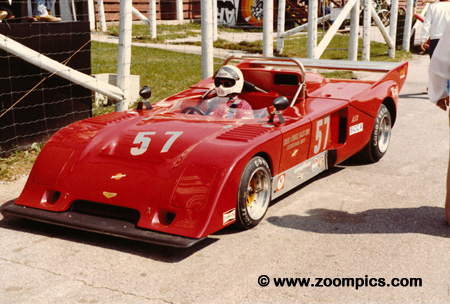

|
For many reasons, the original Canadian American Challenge Cup (Can Am) series ended in 1974.
To fill this vacancy, the Sports Car Club of America’s (SCCA) premier series became the Formula 5000 Championship.
The replacement series was short-lived and only lasted two seasons. By the end of 1976, race promoters were
no longer interested in the Formula 5000 cars as they felt they were not attracting race fans.
Also, a sponsor could not be found for the series. Finally, USAC, which co-sanctioned the events with the SCCA,
was not going to return in 1977. As a result of these factors, SCCA decided to revive the Can Am but with rules
that were not as liberal as the original series.
The new regulations allowed Formula 5000 cars to compete with sports racer bodies. Lola produced a conversion kit that transformed the Lola T-332 C to a full-bodied T-333 CS. Motors were limited to 5-liter stock block V8s or 3-liter racing engines. To fill the grids, under 2-liter sports racers were eligible to participate. The new Can Am series debuted in 1977 at Le Circuit Mont Tremblant, Quebec, with seventeen cars starting the race. In all, nine events were contested during the season. Patrick Tambay won the championship in a Lola T-333 CS entered by Carl Haas. The 1981 season opened in June with the first of two visits to Mosport Park. Then teams travelled to the United States for races at the Mid-Ohio Sports Car Course, Watkins Glen International and Road America. After Road America, the series headed north of the border to compete at Edmonton, Trois-Rivieres and Mosport. The final three rounds of the year were held in October at Riverside International Raceway, Laguna Seca and Caesars Palace. The second event at Mosport was held on a warm and sunny day in September. Fabi scored another win at Mosport which added to his 1981 series total of four victories. But it was Geoff Brabham who captured the championship win two wins and consistency - finishing out of the top three only twice. The under 2-litre title went to Jim Truman in a Ralt RT-2. |

|

|
Qualifying second in the under 2-liter class at Mosport was Tim Evans in a Cicale bodied Ralt RT-1. Evans finished fourth in class behind Paul Macey, John Graham and Jim Trueman. |

|

|
This Chevron B36 was driven by Dick Leppla. He entered the Mid-Ohio event and finished fifth in the under 2-litre class. Unfortunately, he was unable to start the Mosport race. |


| POS. | CLASS | DRIVER | CAR | ENTRANT | LAPS | RETIREMENTS |
|---|---|---|---|---|---|---|
| 1 | - | Teo Fabi | March 817 | Paul Newman/Budweiser | 60 | - |
| 2 | - | Bobby Rahal | March 817 | Paul Newman/Budweiser | 60 | - |
| 3 | - | Geoff Brabham | VDS 001 | VDS Racing Team | 60 | - |
| 4 | - | Tom Klausler | Frissbee KR2 | U.S. Racing | 58 | - |
| 5 | U2L | Paul Macey | Lola T-294 | GPS Racing | 52 | - |
| 6 | U2L | John Graham | Chevron B21 | Midland Racing | 51 | - |
| 7 | - | Danny Sullivan | Lola T-530 | Garvin Brown Racing | 50 | Transmission |
| 8 | - | Jeff Wood | Lola T-530 | Carl Haas/Magicolor Paint | 49 | Tire |
| 9 | U2L | Jim Trueman | Cicale Ralt RT-2 | Red Roof Inns | 49 | Suspension |
| 10 | - | Danny Johnson | Chevron B24 | Johnson Comp Ent | 49 | Suspension |
| 11 | U2L | Tim Evans | Cicale Ralt RT-1 | Red Roof Inns | 48 | - |
| 12 | - | Mike Freeberg | Lola T-332 | Kroll Racing | 38 | Engine |
| 13 | U2L | Bob Roy | March 744 | Copes Plus | 34 | - |
| 14 | U2L | Greg Sorrentino | March 79S | - | 31 | - |
| 15 | - | Al Holbert | CAC-2 | CRC Chemicals | 1 | Engine |
| 16 | U2L | Michael Prevost | Lola T-212 | - | 1 | Engine |
| DNS | - | Horst Kroll | Lola T-332 | Kroll Racing | 0 | - |
| DNS | U2L | Dick Leppla | Chevron B36 | Crane & Shovel Sales | 0 | - |
| DNS | U2L | Roman Pechmann | Lola T-290 | Pechman Racing | 0 | - |
| Copyright Notice: |
| All content (photographs and text) appearing on this website are the exclusive property of © www.zoompics.com and are protected under International copyright laws. The subject matter on this website may not be reproduced, copied, stored or manipulated. |